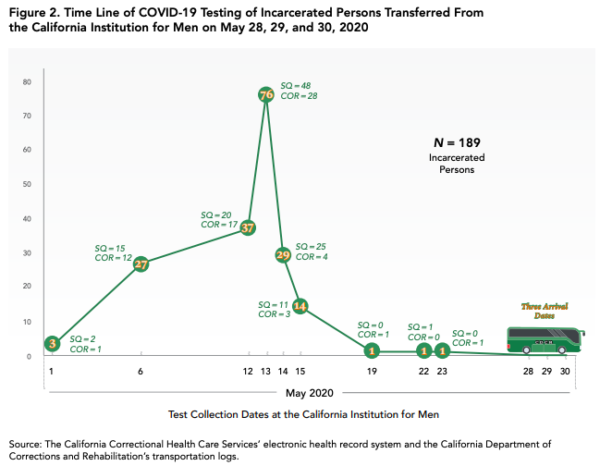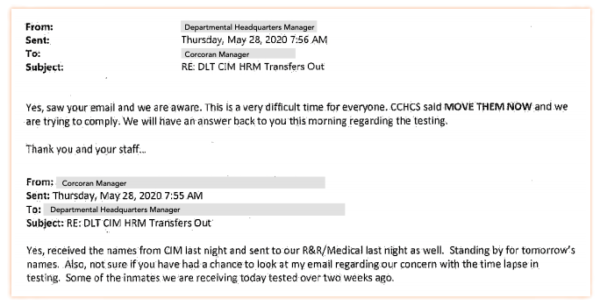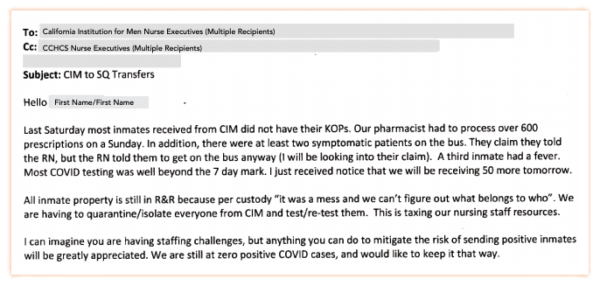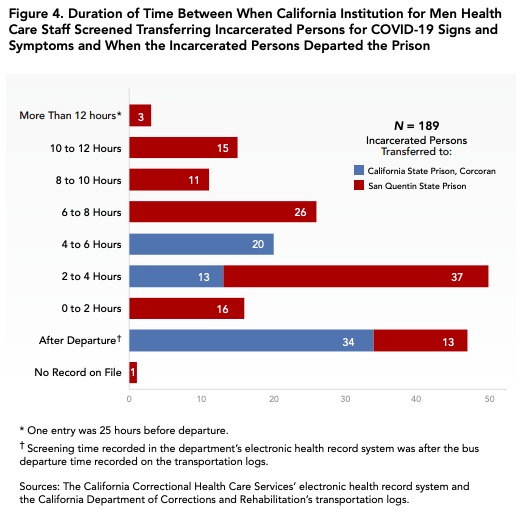
In the heels of its two previous reports (see 1 and 2), and just in time for Round 2 of litigation in In re Von Staich (to assess whether an evidentiary hearing is required to modify the original order) comes the much-anticipated Part 3 of the Office of the Inspector General’s review of CDCR’s (mis)handling of the COVID-19 disaster. The report, which you can read in full here or peruse the fact sheet, is a scathing narrative of how CDCR botched the transfer from CIM in Chino to San Quentin and Corcoran prisons, bringing about the worst prison medical disaster in the United States. The report does not mince words: It is titled California Correctional Health Care Services and the California Department of Corrections and Rehabilitation Caused a Public Health Disaster at San Quentin State Prison When They Transferred Medically Vulnerable Incarcerated Persons From the California Institution for Men Without Taking Proper Safeguards.
The executive summary reads as follows:
Our review found that the efforts by CCHCS and the department to prepare for and execute the transfers were deeply flawed and risked the health and lives of thousands of incarcerated persons and staff. Insistence by CCHCS and the department to execute the transfers and subsequent pressure to meet a tight deadline resulted in the California Institution for Men ignoring concerns from health care staff and transferring the medically vulnerable incarcerated persons, even though the vast majority had not been recently tested for COVID-19. With outdated test results, the prison had no way to know whether any of the incarcerated persons were currently infected with the virus. According to email conversations that we reviewed, a California Institution for Men health care executive explicitly ordered that the incarcerated persons not be retested the day before the transfers began, and multiple CCHCS and departmental executives were aware of the outdated nature of the tests before the transfers occurred.
In addition to the department transferring the medically vulnerable incarcerated persons despite outdated tests, prison health care staff conducted verbal and temperature screenings on multiple transferring incarcerated persons too early to determine whether they had symptoms of COVID-19 when they boarded the buses. As a result, some of the incarcerated persons may have been experiencing symptoms consistent with COVID-19 when they left the prison. The risk of placing some symptomatic incarcerated persons on the buses was exacerbated by another inexplicable decision approved by CCHCS executives to increase the number of incarcerated persons on some of the buses, thus decreasing the physical distance between them, and increasing the risk that the virus could spread among the incarcerated persons and staff on the buses.
Once the incarcerated persons arrived at San Quentin, nursing staff immediately noted that two of the incarcerated persons arrived with symptoms consistent with COVID-19. Nonetheless, the prison housed almost all of the incarcerated persons who arrived from the California Institution for Men in a housing unit without solid doors, allowing air to flow in and out of the cells. By the time the prison tested the incarcerated persons for COVID-19, many of those who tested positive had been housed in the unit for at least six days. The virus then spread quickly through the housing unit and to multiple areas throughout the prison. The prison’s inability to properly quarantine and isolate incarcerated persons exposed to or infected with COVID-19, along with its practice of allowing staff to work throughout the prison during shifts or on different days, likely caused the virus to spread to multiple areas of the prison. According to data the department provided to support its COVID-19 population tracker, by the end of August 2020, 2,237 incarcerated persons and 277 staff members became infected with the virus. In addition, 28 incarcerated persons and one staff member died as a result of complications from COVID-19. In contrast, Corcoran, likely because it is a much newer prison consisting mostly of cells with solid doors, experienced a much smaller outbreak. An animated graphic displaying the progression of the COVID-19 outbreaks coursing through the various housing units at San Quentin and Corcoran after the transfers had been effected can be viewed on our website at www.oig.ca.gov.
Our review also found that when staff became aware of the positive test results shortly after the incarcerated persons arrived, both prisons failed to properly conduct contact tracing investigations. According to San Quentin, there were too many positive cases over a short period of time to conduct contact tracing. In addition, Corcoran staff failed to identify any contacts other than those living in cells adjacent to those of the incarcerated persons who tested positive. By failing to thoroughly conduct contact tracing, the prisons may have failed to alert some close contacts of the infected individuals, increasing the risk of further spread of the virus.
The report determined that the COVID-19 tests for almost all of the 122 men who were transferred to San Quentin were more than two weeks old by the time of transfer:

The report reproduces emails of directors and administrators within CCHCS who explicitly denied the staff’s requests to test the men before the transfer:

One nurse administrator documented the fact that two people on the bus were already symptomatic but were ordered to go on the bus anyway:

Symptom-checking was conducted too soon to be useful:

After a devastating section recounting how CCHCS administrators opted to transfer people in the bus without social distancing because “the benefit of a more rapid move in this specific situation appears to outweigh the risks” (p. 39), the report covers ground we already know–the failure at Quentin to properly isolate the newcomers. The report does not go into the interaction between the Marin county officials and the prison officials, which make the picture even bleaker. It also explains why a similar calamity did not occur at Corcoran: “Compared with San Quentin, Corcoran is a modern prison with a design better suited for quarantining and isolating incarcerated persons. Because the prison’s housing predominantly consists of cells with solid doors, Corcoran was able to place all arriving incarcerated persons in cells with solid doors. Doing so likely significantly reduced the spread of the virus at the prison, as only two of the 67 incarcerated persons who transferred from the California Institution for Men contracted the virus after the transfer” (p. 42.) Against this backdrop, the location chosen to house the newcomers seems even more disturbing–the report includes images of mesh doors in the South Block unit, also known as the Badger unit.
One aspect of the report that seems especially important is the repeated reference to the fact that the prison authorities were aware of the risks they were taking. The email chains reproduced in the report are truly damning in terms of their evidentiary power. This matters because prevailing in a lawsuit about prison conditions requires not only negligence, but a higher standard known as “deliberate indifference.” This requires proving that authorities were aware of the risk they were creating and decided to act anyway. Seeing how this awareness permeated all levels of command within CDCR/CCHCS offers proof of deliberate indifference, and it is hard to think, given the actions of the prison once the newcomers were there, that they could show anything in mitigation.
Obviously, this has crucial legal ramifications for Von Staich, Ruiz, Hall, and beyond, so CDCR/CCHCS have issued a joint statement, according to which they “disagree with the information” in the report. This is nonsensical. One can disagree with an opinion, but to “disagree” with information? The information is either true or not true, and in this case it’s rather obvious it’s true, as the emails are screenshot and reproduced verbatim in the report. We know what happened, we have obvious, factual truth that they knew and chose to disregard the risk, and no milquetoast “disagreement” is going to change that.




No comment yet, add your voice below!